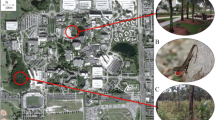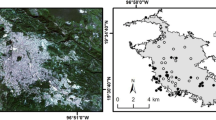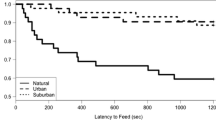Abstract
The development of urban areas imposes challenges that wildlife must adapt to in order to persist in these new habitats. One of the greatest changes brought by urbanization has been an increase in anthropogenic noise, with negative consequences for the natural behavior of animals. Small mammals are particularly vulnerable to urbanization and noise, despite some species having successfully occupied urban environments. To understand some of the traits that have enabled small mammals to deal with the consequences of urbanization, we compared the behavioral responses of urban and rural greater white-toothed shrews, Crocidura russula, to different sound stimuli. A total of 32 shrews, 16 from each habitat, were exposed in captivity to four sound treatments: silence, tawny owl calls, traffic noise, and white noise. Urban and rural shrews showed different behaviors, with urban animals being more active, feeding more frequently, and using less torpor than rural individuals. However, responses to sound treatments were similar in both populations: urban and rural shrews exhibited a slight decrease in activity and feeding behavior, as well as more fleeing responses, when exposed to traffic noise or white noise, but not to owl calls. These results suggest urbanization induces long-term changes in the general activity of C. russula, but the short-term behavioral response to sound disturbance remains similar in rural and urban populations.





Similar content being viewed by others
Data availability
Datasets and R code used in formal analysis will be available on figshare upon acceptance for publication.
References
ASAB/ABS (2018) Guidelines for the treatment of animals in behavioural research and teaching. Anim Behav 135:I–X. https://doi.org/10.1016/j.anbehav.2017.10.001
Barber JR, Crooks KR, Fristrup KM (2010) The costs of chronic noise exposure for terrestrial organisms. Trends Ecol Evol 25:180–189. https://doi.org/10.1016/j.tree.2009.08.002
Bartoń K (2019) MuMIn: multi-model inference. R package ver. 1.43.6
Baxter RM, Goulden EA, Meester J (1979) The activity patterns of some southern African Crocidura in captivity. Acta Theriol 24:61–68. https://doi.org/10.4098/AT.arch.79-7
Bieber C, Ruf T (2009) Summer dormancy in edible dormice (Glis glis) without energetic constraints. Naturwissenschaften 96:165–171. https://doi.org/10.1007/s00114-008-0471-z
Boyles JG, Smit B, McKechnie AE (2011) A new comparative metric for estimating heterothermy in endotherms. Physiol Biochem Zool 84:115–123. https://doi.org/10.1086/656724
Bozinovic F, Muñoz JLP, Naya DE, Cruz-Neto AP (2007) Adjusting energy expenditures to energy supply: food availability regulates torpor use and organ size in the Chilean mouse-opossum Thylamys elegans. J Comp Physiol B 177:393–400. https://doi.org/10.1007/s00360-006-0137-0
Branis M, Burda H (1994) Visual and hearing biology of shrews. Carnegie Museum Nat Hist 18:189–200
Buxton RT, McKenna MF, Brown E et al (2020) Varying behavioral responses of wildlife to motorcycle traffic. Glob Ecol Conserv 21:e00844. https://doi.org/10.1016/j.gecco.2019.e00844
Capizzi D (2000) Diet shifts of the tawny owl Strix aluco in central and northern Italy. Ital J Zool 67:73–79. https://doi.org/10.1080/11250000009356298
Cavia R, Cueto GR, Suárez OV (2009) Changes in rodent communities according to the landscape structure in an urban ecosystem. Landsc Urban Plan 90:11–19. https://doi.org/10.1016/j.landurbplan.2008.10.017
Dammhahn M, Mazza V, Schirmer A, Göttsche C, Eccard JA (2020) Of city and village mice: behavioural adjustments of striped field mice to urban environments. Sci Rep 10:1–12. https://doi.org/10.1038/s41598-020-69998-6
Doucette LI, Brigham RM, Pavey CR, Geiser F (2012) Prey availability affects daily torpor by free-ranging Australian owlet-nightjars (Aegotheles cristatus). Oecologia 169:361–372. https://doi.org/10.1007/s00442-011-2214-7
Dowding CV, Harris S, Poulton S, Baker PJ (2010) Nocturnal ranging behaviour of urban hedgehogs, Erinaceus europaeus, in relation to risk and reward. Anim Behav 80:13–21. https://doi.org/10.1016/j.anbehav.2010.04.007
Eötvös CB, Magura T, Lövei GL (2018) A meta-analysis indicates reduced predation pressure with increasing urbanization. Landsc Urban Plan 180:54–59. https://doi.org/10.1016/j.landurbplan.2018.08.010
Fife D (2017) Fifer: a biostatisticians toolbox for various activities, including plotting, data cleanup, and data analysis. R package ver. 1.2
Finch D, Schofield H, Mathews F (2020) Traffic noise playback reduces the activity and feeding behaviour of free-living bats. Environ Pollut 263:114405. https://doi.org/10.1016/j.envpol.2020.114405
Francis CD, Barber JR (2013) A framework for understanding noise impacts on wildlife: an urgent conservation priority. Front Ecol Environ 11:305–313. https://doi.org/10.1890/120183
Francis CD, Ortega CP, Cruz A (2009) Noise pollution changes avian communities and species interactions. Curr Biol 19:1415–1419. https://doi.org/10.1016/j.cub.2009.06.052
Friard O, Gamba M (2016) BORIS: a free, versatile open-source event-logging software for video/audio coding and live observations. Methods Ecol Evol 7:1325–1330. https://doi.org/10.1111/2041-210X.12584
Frid A, Dill LM (2002) Human-caused disturbance stimuli as a form of predation risk. Conserv Ecol 6:art11. https://doi.org/10.5751/ES-00404-060111
Gaynor KM, Hojnowski CE, Carter NH, Brashares JS (2018) The influence of human disturbance on wildlife nocturnality. Science 360(80):1232–1235. https://doi.org/10.1126/science.aar7121
Geiser F, Brigham RM (2012) The other functions of torpor. In: Living in a seasonal world. Springer, Berlin Heidelberg, Berlin, Heidelberg, pp 109–121
Genoud M, Vogel P (1981) The activity of Crocidura russula (Insectivora, Soricidae) in the field and in captivity. Zeitschrift für Säugetierkd 46:222–232
Gentry KE, Derryberry EP, Danner RM, Danner JE, Luther DA (2017) Immediate signaling flexibility in response to experimental noise in urban, but not rural, white-crowned sparrows. Ecosphere 8:e01916. https://doi.org/10.1002/ecs2.1916
Gomes V, Ribeiro R, Carretero MA (2011) Effects of urban habitat fragmentation on common small mammals: species versus communities. Biodivers Conserv 20:3577–3590. https://doi.org/10.1007/s10531-011-0149-2
Grissom N, Bhatnagar S (2009) Habituation to repeated stress: get used to it. Neurobiol Learn Mem 92:215–224. https://doi.org/10.1016/j.nlm.2008.07.001
Halfwerk W, Holleman LJM, Lessells CM, Slabbekoorn H (2011) Negative impact of traffic noise on avian reproductive success. J Appl Ecol 48:210–219. https://doi.org/10.1111/j.1365-2664.2010.01914.x
Hendrie CA, Weiss SM, Eilam D (1998) Behavioural response of wild rodents to the calls of an owl: a comparative study. J Zool 245:439–446. https://doi.org/10.1111/j.1469-7998.1998.tb00118.x
Hendry AP, Farrugia TJ, Kinnison MT (2008) Human influences on rates of phenotypic change in wild animal populations. Mol Ecol 17:20–29. https://doi.org/10.1111/j.1365-294X.2007.03428.x
Herde A, Eccard JA (2013) Consistency in boldness, activity and exploration at different stages of life. BMC Ecol 13:49. https://doi.org/10.1186/1472-6785-13-49
Hölker F, Wolter C, Perkin EK, Tockner K (2010) Light pollution as a biodiversity threat. Trends Ecol Evol 25:681–682. https://doi.org/10.1016/j.tree.2010.09.007
Hutterer R (1977) Paarungsrufe der Wasserspitzmaus (Neomys fodiens) und verwandte Laute weiterer Soricidae. Zeitschrift für Säugetierkd 43:330–336
ICNF (2018) Fauna do Parque Natural de Sintra-Cascais. http://www2.icnf.pt/portal/ap/p-nat/pnsc/fauna
Joo W, Gage SH, Kasten EP (2011) Analysis and interpretation of variability in soundscapes along an urban–rural gradient. Landsc Urban Plan 103:259–276. https://doi.org/10.1016/j.landurbplan.2011.08.001
Kight CR, Swaddle JP (2011) How and why environmental noise impacts animals: an integrative, mechanistic review. Ecol Lett 14:1052–1061. https://doi.org/10.1111/j.1461-0248.2011.01664.x
Klett-Mingo JI, Pavón I, Gil D (2016) Great tits, Parus major, increase vigilance time and reduce feeding effort during peaks of aircraft noise. Anim Behav 115:29–34. https://doi.org/10.1016/j.anbehav.2016.02.021
Klimant P, Klimantová A, Baláž I, Jakab I, Tulis F, Rybanský Ľ, Vadel Ľ, Krumpálová Z (2017) Small mammals in an urban area: habitat preferences and urban-rural gradient in Nitra city, Slovakia. Polish J Ecol 65:144–157. https://doi.org/10.3161/15052249PJE2017.65.1.013
Konstantinov AI, Movchan VN (1985) Acoustic communication in different groups of mammals. In: sounds in the life of animals (in Russian). Leningrad, pp 63–81
Kronfeld-Schor N, Dayan T (2013) Thermal ecology, environments, communities, and global change: energy intake and expenditure in endotherms. Annu Rev Ecol Evol Syst 44:461–480. https://doi.org/10.1146/annurev-ecolsys-110512-135917
Lahti DC, Johnson NA, Ajie BC, Otto SP, Hendry AP, Blumstein DT, Coss RG, Donohue K, Foster SA (2009) Relaxed selection in the wild. Trends Ecol Evol 24:487–496. https://doi.org/10.1016/j.tree.2009.03.010
Lausen CL, Barclay RMR (2006) Benefits of living in a building: big brown bats (Eptesicus fuscus) in rocks versus buildings. J Mammal 87:362–370. https://doi.org/10.1644/05-MAMM-A-127R1.1
Leslie AM, Stewart M, Price E, Munn AJ (2015) Daily changes in food availability, but not long-term unpredictability, determine daily torpor-bout occurrences and frequency in stripe-faced dunnarts (Sminthopsis macroura). Aust J Zool 63:12. https://doi.org/10.1071/ZO14058
Levy O, Dayan T, Kronfeld-Schor N (2011) Interspecific competition and torpor in golden spiny mice: two sides of the energy-acquisition coin. Integr Comp Biol 51:441–448. https://doi.org/10.1093/icb/icr071
Łopucki R, Kitowski I (2017) How small cities affect the biodiversity of ground-dwelling mammals and the relevance of this knowledge in planning urban land expansion in terms of urban wildlife. Urban Ecosyst 20:933–943. https://doi.org/10.1007/s11252-016-0637-y
Lowry H, Lill A, Wong BBM (2013) Behavioural responses of wildlife to urban environments. Biol Rev 88:537–549. https://doi.org/10.1111/brv.12012
Luo J, Clarin B-M, Borissov IM, Siemers BM (2014) Are torpid bats immune to anthropogenic noise? J Exp Biol 217:1072–1078. https://doi.org/10.1242/jeb.092890
Mancera KF, Besson M, Lisle A, Allavena R, Phillips CJC (2018) The effects of mining machinery noise of different amplitudes on the behaviour, faecal corticosterone and tissue morphology of wild mice (Mus musculus). Appl Anim Behav Sci 203:81–91. https://doi.org/10.1016/j.applanim.2018.02.010
McKinney ML (2008) Effects of urbanization on species richness: a review of plants and animals. Urban Ecosyst 11:161–176. https://doi.org/10.1007/s11252-007-0045-4
Nagel A (1977) Torpor in the European white-toothed shrews. Experientia 33:1455–1456. https://doi.org/10.1007/BF01918804
Neo YY, Hubert J, Bolle LJ, Winter HV, Slabbekoorn H (2018) European seabass respond more strongly to noise exposure at night and habituate over repeated trials of sound exposure. Environ Pollut 239:367–374. https://doi.org/10.1016/j.envpol.2018.04.018
Nowack J, Stawski C, Geiser F (2017) More functions of torpor and their roles in a changing world. J Comp Physiol B 187:889–897. https://doi.org/10.1007/s00360-017-1100-y
Oliveira FG, Tapisso JT, Monarca RI, Cerveira AM, Mathias ML (2016) Phenotypic flexibility in the energetic strategy of the greater white-toothed shrew, Crocidura russula. J Therm Biol 56:10–17. https://doi.org/10.1016/j.jtherbio.2015.12.002
Oliveira FG, Mathias ML, Rychlik L et al (2020a) Metabolic and behavioral adaptations of greater white-toothed shrews to urban conditions. Behav Ecol 31:1334–1343. https://doi.org/10.1093/beheco/araa088
Oliveira FG, Tapisso JT, von Merten S, Rychlik L, Fonseca PJ, Mathias ML (2020b) Data from: Behavioral responses of rural and urban greater white-toothed shrews (Crocidura russula) to sound disturbance. figshare, v1. https://doi.org/10.6084/m9.figshare.13292696
Orrock JL (2010) When the ghost of predation has passed: do rodents from islands with and without fox predators exhibit aversion to fox cues? Ethology 116:338–345. https://doi.org/10.1111/j.1439-0310.2010.01740.x
Pieniążek A, Boguszewski PM, Meronka RA (2017) The impact of urban noise on the behavior of two mouse species belonging to the genus Apodemus. Nat Resour 8:55–68. https://doi.org/10.4236/nr.2017.82004
Pinheiro J, Bates D, DebRoy S, et al (2019) Package “nlme”: linear and nonlinear mixed effects models. R package ver. 3.1-140
R Core Team (2018) R: a language and environment for statistical computing. R Found. Stat. Comput
Rangel-Patiño C, García-Morales C, Mastachi-Loza C, Carmen-Cristóbal JM, Ruiz-Gómez ML (2018) Personality and its variation between sexes in the black-bellied bunchgrass lizard Sceloporus aeneus during the breeding season. Ethology 124:796–803. https://doi.org/10.1111/eth.12814
Read J, Jones G, Radford AN (2014) Fitness costs as well as benefits are important when considering responses to anthropogenic noise. Behav Ecol 25:4–7. https://doi.org/10.1093/beheco/art102
Russo D, Ancillotto L (2015) Sensitivity of bats to urbanization: a review. Mamm Biol 80:205–212. https://doi.org/10.1016/j.mambio.2014.10.003
Seress G, Liker A (2015) Habitat urbanization and its effects on birds. Acta Zool Acad Sci Hungaricae 61:373–408. https://doi.org/10.17109/AZH.61.4.373.2015
Seto KC, Guneralp B, Hutyra LR (2012) Global forecasts of urban expansion to 2030 and direct impacts on biodiversity and carbon pools. Proc Natl Acad Sci 109:16083–16088. https://doi.org/10.1073/pnas.1211658109
Shannon G, Angeloni LM, Wittemyer G, Fristrup KM, Crooks KR (2014) Road traffic noise modifies behaviour of a keystone species. Anim Behav 94:135–141. https://doi.org/10.1016/j.anbehav.2014.06.004
Shannon G, McKenna MF, Angeloni LM et al (2016) A synthesis of two decades of research documenting the effects of noise on wildlife. Biol Rev 91:982–1005. https://doi.org/10.1111/brv.12207
Sih A, Stamps J, Yang LH, McElreath R, Ramenofsky M (2010) Behavior as a key component of integrative biology in a human-altered world. Integr Comp Biol 50:934–944. https://doi.org/10.1093/icb/icq148
Sol D, Lapiedra O, González-Lagos C (2013) Behavioural adjustments for a life in the city. Anim Behav 85:1101–1112. https://doi.org/10.1016/j.anbehav.2013.01.023
Taylor JRE (1998) Evolution of energetic strategies in shrews. In: Wójcik JM, Wolsan M (eds) Evolution of shrews. Mammal Research Institute, Polish Academy of Sciences, Białowieża, Poland, pp 309–346
Turbill C, Stojanovski L (2018) Torpor reduces predation risk by compensating for the energetic cost of antipredator foraging behaviours. Proc R Soc B Biol Sci 285:20182370. https://doi.org/10.1098/rspb.2018.2370
Uchida K, Suzuki KK, Shimamoto T, Yanagawa H, Koizumi I (2019) Decreased vigilance or habituation to humans? Mechanisms on increased boldness in urban animals. Behav Ecol 30:1583–1590. https://doi.org/10.1093/beheco/arz117
Vergnes A, Kerbiriou C, Clergeau P (2013) Ecological corridors also operate in an urban matrix: a test case with garden shrews. Urban Ecosyst 16:511–525. https://doi.org/10.1007/s11252-013-0289-0
Vincze E, Papp S, Preiszner B, Seress G, Bókony V, Liker A (2016) Habituation to human disturbance is faster in urban than rural house sparrows. Behav Ecol 27:1304–1313. https://doi.org/10.1093/beheco/arw047
Vuarin P, Henry P-Y (2014) Field evidence for a proximate role of food shortage in the regulation of hibernation and daily torpor: a review. J Comp Physiol B 184:683–697. https://doi.org/10.1007/s00360-014-0833-0
Willis CKR, Goldzieher A, Geiser F (2005) A non-invasive method for quantifying patterns of torpor and activity under semi-natural conditions. J Therm Biol 30:551–556. https://doi.org/10.1016/j.jtherbio.2005.07.001
Yorzinski JL, Ziegler T (2007) Do naïve primates recognize the vocalizations of felid predators? Ethology 113:1219–1227. https://doi.org/10.1111/j.1439-0310.2007.01435.x
Zsebők S, Czabán D, Farkas J, Siemers BM, von Merten S (2015) Acoustic species identification of shrews: twittering calls for monitoring. Ecol Inform 27:1–10. https://doi.org/10.1016/j.ecoinf.2015.02.002
Zuur AF, Ieno EN, Elphick CS (2010) A protocol for data exploration to avoid common statistical problems. Methods Ecol Evol 1:3–14. https://doi.org/10.1111/j.2041-210X.2009.00001.x
Acknowledgements
We thank users “sean.townsend”, “YleArkisto” and “Benboncan” for allowing us to freely download tawny owl calls and users “Robinhood76” and “C klankbeeld 2014” for allowing us to freely download traffic noise recordings from the freesound.org website. Some tawny owl calls were also kindly provided by Dr. Tomi Trilar from the Slovenian Museum of Natural History. We thank Câmara Municipal de Lisboa (CML), Museu de Lisboa, and Faculdade de Ciências, Universidade de Lisboa for permission to trap shrews in their green spaces, and Parques de Sintra – Monte da Lua, namely Inês Moreira, for permission to trap shrews in Sintra. We thank the valuable help of field assistants, namely: Ana Cerveira, Ana Filipa Durão, Daniel Mameri, Diogo Barros, Fernando Madeira, Inês Fontes, João Gameiro, Pedro David, Rita Andrade, Sara Oliveira, Telma Laurentino, Tiago Maçarico and Welvis Fernandes.
Funding
Thanks are due to FCT/MCTES for the financial support to CESAM (UIDP/50017/2020 + UIDB/50017/2020), through national funds. This work was supported through a PhD grant (ref: PD/BD/109400/2015) granted to FGO and financed by the Portuguese Foundation for Science and Technology (FCT).
Author information
Authors and Affiliations
Contributions
Conceptualization: Flávio G. Oliveira, Joaquim T. Tapisso and Maria da Luz Mathias; Methodology and resources: Flávio G. Oliveira, Joaquim T. Tapisso and Paulo J. Fonseca; Investigation and formal analysis: Flávio G. Oliveira; Writing – original draft: Flávio G. Oliveira and Paulo J. Fonseca; Writing – review and editing: Joaquim T. Tapisso, Sophie von Merten, Leszek Rychlik and Maria L. Mathias; Supervision: Joaquim T. Tapisso, Leszek Rychlik and Maria da Luz Mathias; Funding acquisition: Maria da Luz Mathias.
Corresponding author
Ethics declarations
Competing interests
The authors declare they have no competing interests.
Ethics approval
The handling, capture and transportation of shrews were authorized by Instituto da Conservação da Natureza e Florestas (ICNF, license number 37/2016/CAPT). Maintenance and testing procedures were stated by a competent authority (ORBEA 3/2017) to be in accordance with the requirements following the European guidelines (Directive 2010/63/EU) transposed to Portuguese law (decree-law number 113/2013). Shrews were cared for in accordance with the Animal Behavior guidelines for the treatment of animals in behavioral research and teaching (ASAB/ABS 2018). Disturbance to captive animals was minimized by avoiding handling between tests and only checking shrews once every day when food and water were replenished. No animals died or showed evident signs of distress during or following a trial. After approximately three weeks, captive shrews were released at their original trapping site.
Consent to participate
Not applicable.
Consent for publication
Not applicable.
Code availability
Analyses reported in this article can be reproduced using the data provided by Oliveira et al. (2020b)
Supplementary Information
ESM 1
(DOCX 0.98 mb)
Rights and permissions
About this article
Cite this article
Oliveira, F.G., Tapisso, J.T., von Merten, S. et al. Behavioral responses of rural and urban greater white-toothed shrews (Crocidura russula) to sound disturbance. Urban Ecosyst 24, 851–862 (2021). https://doi.org/10.1007/s11252-020-01079-y
Accepted:
Published:
Issue Date:
DOI: https://doi.org/10.1007/s11252-020-01079-y




